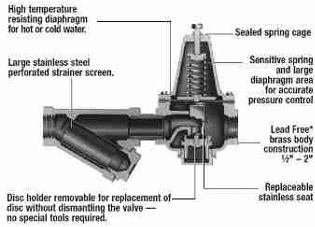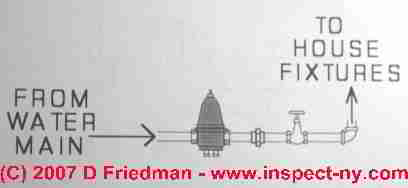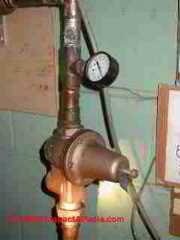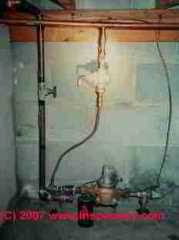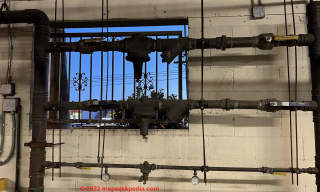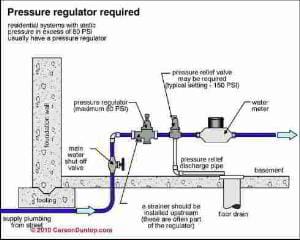 Diagnose & Repair Building Water Pressure Regulators & Water Pressure Reducing Valves
Diagnose & Repair Building Water Pressure Regulators & Water Pressure Reducing Valves
- POST a QUESTION or COMMENT about water pressure regulators and water pressure reducer valves
Water pressure regulator controls:
This article describes how to diagnose & repair a bad water pressure reducing valve or water pressure regulator that can result in either building water pressure and flow that are too weak, or building water pressure that is dangerously high. Distinguishing between static water pressure, dynamic water pressure, and water flow rate can help diagnose water problems in a building.
Here we explain these concepts and we describe how to measure water pressure and flow at a property where either municipal water supply or a private well and pump water supply is in use. Our sketch at page top, courtesy of Carson Dunlop Associates, shows the key components found where municipal water supply enters a building.
InspectAPedia tolerates no conflicts of interest. We have no relationship with advertisers, products, or services discussed at this website.
- Daniel Friedman, Publisher/Editor/Author - See WHO ARE WE?
What is a Water Pressure Regulator or Pressure Reducing Valve, Where are They Installed, Why?
 Article Contents
Article Contents
- WATER PRESSURE REDUCER / REGULATOR
- WHAT'S A WATER PRESSURE REGULATOR?
- DIRECT-ACTING PRESSURE REDUCING VALVES
- REGULATE HIGH INCOMING WATER PRESSURE
- SELECT PROPER PRESSURE REDUCING VALVE
- WIRE DRAW LEAKS AT PRESSURE REDUCERS
- PARALLEL PRESSURE REDUCING VALVES
- EXPANSION TANKS RELIEVE HIGH PRESSURE
- DIAGNOSE POOR MUNICIPAL WATER PRESSURE
- WATER PRESSURE REGULATOR TEST, REPAIR
- WATER PRESSURE REDUCER / REGULATOR FAQs
Illustration above, adapted from Watts® Series 23B, 123LP, N250, N250B water pressure reducing valve cited below.
[Click to enlarge any image]
Definition of Water Pressure Regulator / Pressure Reducer
A water pressure reducer or pressure reducing valve is a device that lowers high incoming water pressure to a safe level in a building.
A water pressure regulator is a device that attempts to keep building water pressure at a consistent level.
As you can see in the sketch above, the key parts inside a typical water pressure reducing valve are:
- a water inlet port
that accepts the incoming (presumably higher pressure) water supply - an outlet port
that allows water out of the valve to enter the building water piping system - a diaphragm
that is pressed upwards to open a valve to let water flow out of the valve and into the building - an adjustable spring
(green in our sketch adapted from Watts®) whose force counteracts the upwards force of the water on the diaphragm to control the size of the opening through which water flows in response to water pressure - an adjustment screw & lock-nut
that permit changing the spring pressure.
As we detail at WATER PRESSURE REGULATOR ADJUSTMENT on most pressure regulators turning the screw "in" or against the spring pressure will produce "higher water pressure" out of the pressure regulator valve.
While technically these are two different applications of water control devices, in our articles we use the terms water pressure regulators and water pressure reducing valves interchangeably as referring to devices that both regulate the pressure or flow of water from a supply source into a building, and (if high water pressures are present) protect building plumbing systems from excessive water pressure damage by reducing incoming high water main pressure (that can be more than 150 psi in some communities) to a safe level (typically 50 psi) in the building.
Why are water pressure regulators installed on water supplies?
 Often municipal water supply pressure can run quite high, say over 80 psi and in some communities, more than 150 psi.
Often municipal water supply pressure can run quite high, say over 80 psi and in some communities, more than 150 psi.
This high pressure would cause leaks at many ordinary residential plumbing fixtures like sink and tub faucets or toilets, as well as some actually dangerous conditions -
see WATER PRESSURE TOO HIGH: DANGERS.
Our photo above / left shows typical incoming municipal water piping at a building.
From left to right we see a main water shut off valve, a water meter (wires lead to an outdoor water meter reading device), a water pressure regulator, and water piping rising into the building.
So where city or municipal water supply pressures exceed 80 psi, the building should have a pressure reducing valve, also referred to by some as a water pressure regulator installed, usually right after the water meter where water enters the building.
Examples of Pressure Reducing Valves Used to Regulate Municipal Water Supply Pressure
According to Watts Corporation, a producer of water pressure reducing valves,
There are two types of water pressure reducing valves, direct acting and pilot operated. Both use globe or angle style bodies. Valves used on smaller piping diameter units are cast from brass; larger piping diameter units are made from ductile iron.
Direct acting [pressure reducing] valves, the more popular type of a water pressure reducing valves, consist of globe-type bodies with a spring-loaded, heat-resistant diaphragm connected to the outlet of the valve that acts upon a spring.
This spring holds a pre-set tension on the valve seat installed with a pressure equalizing mechanism for precise water pressure control.
Watts produces a Watts Governor 80™ used for this purpose, but other manufacturers also produce a wide variety of water pressure regulators.
For very high incoming water supply pressures, a two-stage serial reduction method is used: two pressure reducing regulating valves are installed in series.
The first pressure reducing valve (for example a Watts Model U5B) reduces incoming water pressure to 150 psi, and the second valve reduces water pressure to 50 psi.
What's the difference between a water pressure regulator valve and a water pressure reducing valve?
Looking over water safety and flow control products offered by Watts (cited atReferences or Citations ), that company lists a range of low pressure regulators and a wide range of high capacity water pressure reducing valves.
We notice that in low pressure regulation applications such as on steam heating systems and on residential water supply systems, control valves are referred to as low pressure regulators (Watts 123LP low water pressure regulator for example - sketch at left).
Series 123LP Low Water Pressure Regulators are used in residential and point-of-use applications to regulate water pressure in piping systems that require low pressure regulation.
...
Maximum Working Pressure: 200psi (13.8 bar), Adjustable Pressure Range: 10 to 30psi (69 to 207 kPa), Reduced Pressure Setting: 25psi (172.4 kPa).
Most of the pressure regulators we see listed refer to low pressure applications on steam systems, residential water systems, or fuel oil systems.
Higher capacity water pressure reducing valves are used in commercial or industrial applications (and some residential applications) where it is necessary to protect the building plumbing system (pipes, water heater tanks, relief valves, etc). from high incoming water pressures and also to conserve water usage.
(Watts LF223 lead-free high capacity water pressure reducing valves, for example - sketch at left).
Series LF223, LF223S Lead Free* High Capacity Water Pressure Reducing Valves are used in commercial, industrial, and institutional applications to reduce incoming water pressure for protection of plumbing system components and to reduce water consumption.
It consists of a Lead Free* brass body construction (2 1/2 in. is iron), enlarged diaphragm, spring cage and seat orifice for super capacity, sealed spring cage for waterworks pit installations and an optional thermal expansion bypass. ... Maximum Working Pressure: 300psi (21 bar), Adjustable Reduced Pressure Range: 25 to 75psi (172 to 517 kPa), Standard Pressure Setting: 50psi (345 kPa).
Watts and other manufacturers produce a wide range of types of water pressure regulators and water pressure reducing valves to handle fluid types, operating pressure ranges, and also responsiveness where the drop in reduced pressure should be kept to a minimum even as the water volume demand varies widely.
An example of a commercial grade high capacity water pressure reducing valve, the Watts Model 127W is shown at left.
OPINION: even after you've seen these two prototypical sketch of a low pressure water regulator and a higher-capacity water pressure reducing valve, in the field, rather than guess which water pressure operating range was intended by the device you're looking at, look for a model number or part number instead.
Building Code Requirement for Pressure Reducing Valves
In fact most national and local plumbing codes require that a water pressure reducing valve should be installed at buildings where municipal water supply pressures (in the water main in the street) exceed 80 psi. Excessive water pressures can burst pipes, cause dripping faucets, and can even cause rupture and explosion of both cold water pressure tanks and hot water storage tanks.
Direct-Acting Pressure Reducing Valves in Residential Properties
In residential properties the pressure regulator likely to be encountered is a direct-acting pressure regulating valve such as the models shown in photographs on this page. Direct acting pressure reducers automatically reduce the incoming water pressure from the municipal supply or water main to a level that is less likely to cause operating or safety problems in the building.
Quoting again from the Watts Corporation,
Water entering the valve from municipal mains is constricted within the valve body and directed through the inner chamber controlled by an adjustable spring loaded diaphragm and disc.
Even if the supply water pressure fluctuates, the pressure reducing valve ensures a constant flow of water at a functional pressure, as long as the supply pressure does not drop below the valve's pre-set pressure.
Watts produces a Watts Governor 80™ used for this purpose, but other manufacturers also produce a wide variety of water pressure regulators.
How to Regulate Very High Incoming Water Pressure: Pressure Reducers in Two Stages
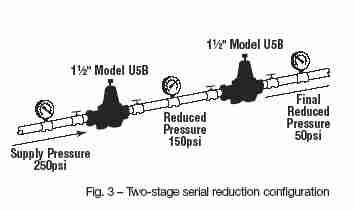
For very high incoming water supply pressures, a two-stage serial reduction method is used:
two pressure reducing regulating valves are installed in series.
The sketch of serial pressure reducing valves (left) is courtesy of Watts Water Technologies and appears in "Water Safety & Flow Control" by that company.
The first pressure reducing valve (for example a
Watts Model U5B) reduces incoming water pressure to 150 psi, and
the second valve reduces water pressure to 50 psi.
Importance of Selecting the Proper Pressure Reducing Valve
If your building already has a water pressure reducer installed, it may be defective or it may be set too high, or the wrong model pressure regulator may be installed.
If the wrong pressure reducing valve model is installed it may not be operating at the water pressure range and flow rates for which it was designed.
The result can be poor performance, noisy plumbing, poor water flow at least at times, not enough water pressure under high-draw conditions,
or WIRE DRAW LEAKS AT PRESSURE REDUCERS
and even dangerous building conditions or risk of building leaks and flooding under low water flow conditions. A more complete catalog of high water pressure problems is found
at WATER PRESSURE TOO HIGH: DANGERS.
Using Parallel Pressure Reducing Valves for Better Maximum Building Water Flow Rate
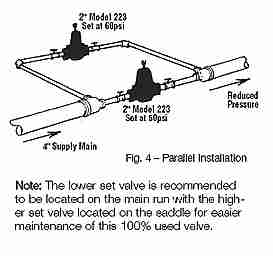
Variations in building occupancy levels: Where building demand for water flow varies widely, a single pressure reducing valve may not be able to handle the maximum water demand flow rate.
This condition occurs at buildings where there is a large water supply main to an apartment or office building whose water demand can vary enormously (0.5 gpm to 100 gpm) depending on the building occupants. Watts and other pressure reducing valve producers recommend a nice solution to this problem (Image above, courtesy of Watts Controls).
As Watts and other manufacturers suggest, parallel pressure reducing valves are sometimes installed to correct this difficulty. One pressure regulator control is set at a higher psi flow rate than the other.
For example installing a Watts Model 223 pressure reducer set at 50 psi in parallel with a second Watts 223 pressure reducer set to 60 psi will allow increased total water flow capacity during periods of peak water demand.
he water pressure regulator can be adjusted to improve building water pressure and thus flow, by loosening a lock nut on the regulator and screwing the adjustment screw up or down a few turns.
Our photo (left) shows the water pressure regulator (photo bottom) and the regulator screw and lock-nut.
Be careful not to set the building water pressure too high, as you'll cause leaks.
For details on adjusting a municipal water pressure regulator
see WATER PRESSURE REGULATOR ADJUSTMENT.
Watch out: don't set the water pressure reducing valve higher than necessary.
Doing so wastes water and as we discuss
at WATER PRESSURE TOO HIGH: DANGERS, setting water pressure too high can cause both plumbing problems and actual serious safety hazards at buildings.
Auxiliary Bleeder Pressure Relief Valves for Thermal Expansion Relief
Watts Corporation points out [in their discussion of their Watts Auxiliary Thermal Expansion Pressure Relief Valve No. 53, Serie3s 530C, 30L, or 111] that a pressure reducing valve may sometimes be ineffective due to high incoming water pressure from the municipal water supply system.
To protect the building heating, hot water, and plumbing system from thermal expansion pressure buildup during intervals of unusually high incoming water pressure, an auxiliary or bleeder pressure relief such as the Watts 530C valve can be installed on either a hot or cold water supply pipe and over a convenient drain location.
Watts also reminds us that some national and regional plumbing codes require that the maximum static water pressure should be not more than 80 psi (5.5 bar).
See DEFINITION OF STATIC WATER PRESSURE
Expansion tanks to relieve high water pressure:
An alternative to installing or changing a water pressure regulator when building water pressure is occasionally 80 psi or higher is the installation of an expansion tank to temporarily absorb that pressure increase.
Proper use of an expansion tank can help avoid unnecessary opening of the pressure/temperature relief valve on a hot water heating tank or a hot water heating boiler.
At HOT WATER PRESSURE EXPANSION RATE we discuss how we measure water pressure and how temperature changes affect water pressure in a closed water heater tank or heating boiler.
For a discussion of temperature and pressure relief safety devices also
see RELIEF VALVE, TP VALVE, BOILER
and RELIEF VALVE, WATER HEATER.
Causes of Variation in Building Water Pressure
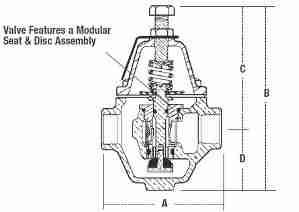 As we discuss in more detail
As we discuss in more detail
at WATER PRESSURE VARIATION CAUSES, there are several causes of variation in building water pressure:
- Number of plumbing fixtures being run at once
- Variation in municipal water delivery pressure
- Variation in small community water systems and private well pump water delivery pressure Details are
at PUMP PRESSURE CONTROL ADJUSTMENT. - Water pipe diameter, length, elbows and bends:
See DEFINITION OF STATIC WATER PRESSURE
and DEFINITION OF DYNAMIC WATER PRESSURE - Clogged water pipes reduce water flow rate, not water pressure.
- Variations in building occupancy levels
How do we Diagnose Poor Municipal Water Pressure & Flow in a Building - 5 Key Checks
Key things to check when water pressure and flow are inadequate in a building served by municipal water supply are
- The condition of individual plumbing fixtures, faucets, valves, and controls.
A clogged sink or shower strainer will cause bad water pressure at individual fixtures while others may flow freely. A plumbing shutoff valve that is partly closed or clogged with debris will cause bad water flow at that fixture. - The incoming municipal supply pressure.
The municipal water supply source may be delivering water at low pressure. - The condition of water piping between the building and the street water main.
An older water supply pipe connecting the building to the water main in the street may be small in diameter, clogged with minerals, rust, or debris, or it could be leaking underground. - The condition of building water supply piping.
Clogged pipes due to minerals or rust, small diameter piping, long piping
For details about the above items,
see MUNICIPAL WATER PRESSURE DIAGNOSIS - The setting of the water pressure regulator at the building
water meter or water shutoff valve. This topic is discussed just below.
Bad water pressure regulator or bad pressure regulator adjustment: (
poor municipal water pressure) if the building is connected to a municipal water supply there may be a water pressure regulator installed, usually close to the water meter or where the water supply pipe enters the building.
If the water pressure control was set too low to start with
or if there is a problem with the water pressure regulator, you may see an improvement in water pressure by diagnosing and adjusting or repairing this control.
If the loss of water pressure was sudden,
it's not likely to be a problem the pressure regulator except in the less common cases of a blockage or failure in the regulator itself.
In this photo our flashlight lights up a (rather amateurish looking) water pressure regulator installed on a municipal water supply.
You can see that a previous connection to the water meter was cut, left shut off (see that shutoff valve at the left hand vertical pipe - what happens if someone opens that valve?), and new fittings were installed to conduct incoming water to the building water supply piping.
The use of smaller diameter flexible copper tubing might restrict the incoming water flow, but the presence of a pressure regulator at all suggests that the incoming pressure may have been excessive. (Too high water pressure leads to fixture leaks.)
Details about how to adjust the building water pressure regulator or pressure reducing valve are found
at WATER PRESSURE REGULATOR ADJUSTMENT.
Increasing the building water pressure by adjusting the pressure regulator (or a pump pressure control switch)
will not
fix a poor water delivery rate from the source (municipal water main or local private water pump), but if the pressure was set too low to start with you may see an improvement by this adjustment.
If your loss of water pressure or flow was sudden, it's not likely to be a problem with the pressure regulator except in the less common cases of a blockage or failure in the regulator itself.
Watch out: don't set the water pressure reducing valve higher than necessary. Doing so wastes water and as we discuss
at WATER PRESSURE TOO HIGH: DANGERS, setting water pressure too high can cause both plumbing problems and actual serious safety hazards at buildings.
...
Reader Comments, Questions & Answers About The Article Above
Below you will find questions and answers previously posted on this page at its page bottom reader comment box.
Reader Q&A - also see RECOMMENDED ARTICLES & FAQs
On 2022-08-10 by InspectApedia-911 (mod) - non lead free PRV is illegal to use in USA
@Plumbing noobie,
Nope, that Apollo Pre-D1X pressure reducing valve, though marked for use with PEX, is not proper for use on potable water supply systems in the United States (if that's where you're located), and not if we read the label on the box correctly. The label plainly states
U.S. Safe Drinking Water Act
It is Illegal to use this product in the United States for potable water services (water intended for human consumption).
From some simple tests we conducted (a long time ago) we found that water that sits for some time, perhaps hours or overnight, in lead-containing plumbing system parts or fixtures, can be high in lead content. That lead is diluted of course as soon as lead-free water begins to run through the fitting or fixture.
But just reading the label ought to be sufficient.
On 2022-08-10 by Plumbing noobie
Hello. I recently had a company come to replace a faulty pressure reducing valve that was under warranty. They replaced the lead free PRV with a non lead free PRV. Is it safe to have this installed in my home?
On 2022-07-15 by InspectApedia-911 (mod) - Can I control a water pressure regulator to go to a specific psi?
@Luke de Vries,
Water pressure regulators can be set to a specific output pressure level. I'm unclear of the relationship between that and wind speed but am guessing perhaps you're using a windmill or wind generator to operate a pump.
I have not found a water pressure regulator that accepts an external control that would vary its pressure setting.
But yes, there are industrial controls that can use an external device to control fluid (water) flow, such as those by Norgren.
On 2022-07-15 by Luke de Vries
Can I control a water pressure regulator to go to a specific psi and determined wind speeds
On 2022-02-06 by Inspectapedia Com Moderator - ask for more information about plumber's diagnosis
@Corbin Williams,
I really would like to be helpful but we have no information whatsoever about the circumstances at your building.
I can't even see enough to know exactly what pressure regulators you have, the type and model and capacity, and I don't know whether there is a question of leakage, failure to regulate the pressure properly, or something else.
It would be perfectly reasonable
to ask for just a little bit more information
when someone makes a terse, almost off-the-cuff remark that you need an expensive repair.
I would say, please tell me what you see or what the problem is so that I can understand it.
On 2022-02-06 by Corbin Williams
My condo has been quoted $10k to replace the 3 regulators pictured because pressure is over 100PSI according to the working gauge in the bottom left. They didn’t even attempt to turn the regulators, they just instantly told us our regulators are all bad?
Any suggestions from you guys with experience? Would love any suggestions, the “commercial plumber” looked at it for 30 seconds and told us the regulators are all bad - that’s not even why we called him out to begin with lol
On 2021-05-31 by inspectapedia.com.moderator - air coming out of the regulator
@PAUL,
Please take a look at
AIR DISCHARGE at FAUCETS, FIXTURES
and at
WATER SUPPLY PIPE WHISTLE NOISE
On 2021-05-31 by PAUL
I hear some air coming out of the regulator. Why?
On 2020-07-20 by danjoefriedman (mod) - What is the estimated cost for installing a new Water Pressure Regulator?
My guess is anywhere between two hundred and $500. The range depends on the particular water pressure regulator that you need and it's cost, and he's of access to removing and replacing the existing one, and also of course where you live is the hourly rates for plumbers vary widely by country and city.
On 2020-07-16 by James
What is the estimated cost for installing a new Water Pressure Regulator?
On 2020-02-24 by danjoefriedman (mod)
Mary
I will be glad to help but first I need to understand what we are talking about. Are we discussing a hot water heating boiler that heats the building, regulating water pressure coming into the building, or a water pressure tank used as part of the water delivery system in the building? Or perhaps a water heater or something else?
On 2020-02-24 by mary l richmond
I just learned we need a PRV for our duplex apts. They have oil fired furnaces with summer winter hook ups so there's an old style metal expansion tank, no hot water heaters per se.
Question: Do we also need an expansion tank installed in addition to the one attached to the furnace for hot water/expansion? Pressure has been 100 psI for a long time it seems; one building has a water hammer thing going on....Help!
On 2018-12-19 by danjoefriedman (mod) - Why was a larger diameter regulator installed on a smaller line?
Ted, I'm not aware of any benefit of installing a size-larger pressure regulator on the water line - often it's a matter of what the plumber had at hand when the work was needed in the first place.
A 3/4" regulator on a 3/4" water supply line should be fine.
Watch out: if you are seeing high overpressure as high as 130 psi there is risk of burst pipes, building flooding, and even personal injury.
On 2018-12-19 by Ted
I have a Watts 600xl "1in" pressure regulator on a "3/4 in" line. Why was a larger diameter regulator installed on a smaller line? Is there advantage to this set up for reducing the incoming water pressure (150 psi)?
I am experiencing water pressure spikes up to 130 psi and need buy a new one but a different model which will require cutting the 3/4 in copper pipe. Does it matter whether I get the 1in pressure regulator or the 3/4in size? Thank you.
...
Continue reading at WATER PRESSURE REGULATOR ADJUSTMENT or select a topic from the closely-related articles below, or see the complete ARTICLE INDEX.
Or see WATER PRESSURE REDUCER / REGULATOR FAQs - questions & answers posted originally on this page
Or see these
Recommended Articles
- CLOGGED SUPPLY PIPES, HOT WATER
- MUNICIPAL WATER PRESSURE DIAGNOSIS
- NO WATER PRESSURE
- WATER PRESSURE GAUGE
- WATER PRESSURE INTERMITTENT LOSS
- WATER PRESSURE LOSS DIAGNOSIS & REPAIR - home
- WATER PRESSURE MEASUREMENT
- WATER PRESSURE PROBLEM DIAGNOSIS TABLE
- WATER PRESSURE REDUCER / REGULATOR
- WATER PRESSURE TOO HIGH: DANGERS
- WATER PRESSURE VARIATION CAUSES
- WATER PUMP CONTROLS & SWITCHES - home
- WELL WATER PRESSURE DIAGNOSIS - home
- WELL WATER PRESSURE IMPROVEMENT
Suggested citation for this web page
WATER PRESSURE REDUCER / REGULATOR at InspectApedia.com - online encyclopedia of building & environmental inspection, testing, diagnosis, repair, & problem prevention advice.
Or see this
INDEX to RELATED ARTICLES: ARTICLE INDEX to WATER SUPPLY, PUMPS TANKS WELLS
Or use the SEARCH BOX found below to Ask a Question or Search InspectApedia
Ask a Question or Search InspectApedia
Try the search box just below, or if you prefer, post a question or comment in the Comments box below and we will respond promptly.
Search the InspectApedia website
Note: appearance of your Comment below may be delayed: if your comment contains an image, photograph, web link, or text that looks to the software as if it might be a web link, your posting will appear after it has been approved by a moderator. Apologies for the delay.
Only one image can be added per comment but you can post as many comments, and therefore images, as you like.
You will not receive a notification when a response to your question has been posted.
Please bookmark this page to make it easy for you to check back for our response.
IF above you see "Comment Form is loading comments..." then COMMENT BOX - countable.ca / bawkbox.com IS NOT WORKING.
In any case you are welcome to send an email directly to us at InspectApedia.com at editor@inspectApedia.com
We'll reply to you directly. Please help us help you by noting, in your email, the URL of the InspectApedia page where you wanted to comment.
Citations & References
In addition to any citations in the article above, a full list is available on request.
- Mark Cramer Inspection Services Mark Cramer, Tampa Florida, Mr. Cramer is a past president of ASHI, the American Society of Home Inspectors and is a Florida home inspector and home inspection educator. Mr. Cramer serves on the ASHI Home Inspection Standards. Contact Mark Cramer at: 727-595-4211 mark@BestTampaInspector.com
- John Cranor [Website: /www.house-whisperer.com ] is an ASHI member and a home inspector (The House Whisperer) is located in Glen Allen, VA 23060. He is also a contributor to InspectApedia.com in several technical areas such as plumbing and appliances (dryer vents). Contact Mr. Cranor at 804-873-8534 or by Email: johncranor@verizon.net
- Watts Water Technologies , 815 Chestnut Street, North Andover, MA, USA 01845-6098, web search 09/18/2010 Watts provides pressure and temperature relief valves, water pressure test gauges, water pressure regulators, backflow preventers, check valves, and other plumbing and heating controls and supplies. Website: http://www.watts.com/
- Watts Backflow preventers - 978-688-1811
- Watts Control valves - 713-943-0688
- "Water Safety & Flow Control / Learn About", original source: http://www.watts.com/pages/learnAbout/reducingValves.asp?catId=64
- Watts Drainage products - 828-288-2179
- Watts Potable water PEX plumbing - 978-688-1811
- Watts Water safety controls - 978-688-1811
- Watts Water quality & conditioning products - 352-465-2000
- Access Water Energy, PO Box 2061, Moorabbin, VIC 3189, Australia, Tel: 1300 797 758, email: sales@accesswater.com.au Moorabbin Office: Kingston Trade Centre, 100 Cochranes Rd, Moorabbin, VIC 3189
Australian supplier of: Greywater systems, Solar power to grid packages, Edwards solar systems, Vulcan compact solar systems, water & solar system pumps & controls, and a wide rage of above ground & under ground water storage tanks: concrete, steel, plastic, modular, and bladder storage tanks. - Smart Tank, Installation Instructions, Flexcon Industries, 300 Pond St., Randolph MA 02368, www.flexconind.com, Tel: 800-527-0030 - web search 07/24/2010, original source: http://www.flexconind.com/pdf/st_install.pdf [Copy on file as /water/Smart_Tank_Flexcon.pdf ] -
- Typical Shallow Well One Line Jet Pump Installation, Grove Electric, G&G Electric & Plumbing, 1900 NE 78th St., Suite 101, Vancouver WA 98665 www.grovelectric.com - web search -7/15/2010 original source: http://www.groverelectric.com/howto/38_Typical%20Jet%20Pump%20Installation.pdf, [Copy on file as /water/Jet_Pump_Grove_Elect_Jet_Pumps.pdf ] -
- Typical Deep Well Two Line Jet Pump Installation, Grove Electric, G&G Electric & Plumbing, 1900 NE 78th St., Suite 101, Vancouver WA 98665 www.grovelectric.com - web search -7/15/2010 original source: http://www.groverelectric.com/howto/38_Typical%20Jet%20Pump%20Installation.pdf, [Copy on file as /water/Jet_Pump_Grove_Elect.pdf ] -
- Cooperative Extension, School of Forest Resources, web search 07/24/2010, original source: http://pubs.cas.psu.edu/FreePubs/pdfs/XH0002.pdf
- Crystal Clear Supply provides portable ceramic water filter purifiers and portable reverse osmosis water treatment equipment - see http://www.crystalclearsupply.com/category_s/7.htm
- Handbook of Disinfectants and Antiseptics, Joseph M. Ascenzi (Editor), CRC, 1995, ISBN-10: 0824795245 ISBN-13: 978-0824795245 "The evaluation of chemical germicides predates the golden age of microbiology..." -
This well-focused, up-to-date reference details the current medical uses of antiseptics and disinfectants -- particularly in the control of hospital-acquired infections -- presenting methods for evaluating products to obtain regulatory approval and examining chemical, physical, and microbiological properties as well as the toxicology of the most widely used commercial chemicals. - Potable Aqua® emergency drinking water germicidal tablets are produced by the Wisconsin Pharmacal Co., Jackson WI 53037. 800-558-6614 pharmacalway.com
- Principles and Practice of Disinfection, Preservation and Sterilization (Hardcover)
by A. D. Russell (Editor), W. B. Hugo (Editor), G. A. J. Ayliffe (Editor), Blackwell Science, 2004. ISBN-10: 1405101997, ISBN-13: 978-1405101998.
"This superb book is the best of its kind available and one that will undoubtedly be useful, if not essential, to workers in a variety of industries. Thirty-one distinguished specialists deal comprehensively with the subject matter indicated by the title ... The book is produced with care, is very readable with useful selected references at the end of each chapter and an excellent index. It is an essential source book for everyone interested in this field. For pharmacy undergraduates, it will complement the excellent text on pharmaceutical microbiology by two of the present editors."
The Pharmaceutical Journal: "This is an excellent book. It deals comprehensively and authoritatively with its subject with contributions from 31 distinguished specialists. There is a great deal to interest all those involved in hospital infection ... This book is exceptionally well laid out. There are well chosen references for each chapter and an excellent index. It is highly recommended." The Journal of Hospital Infection.: "The editors and authors must be congratulated for this excellent treatise on nonantibiotic antimicrobial measures in hospitals and industry ... The publication is highly recommended to hospital and research personnel, especially to clinical microbiologists, infection-control and environmental-safety specialists, pharmacists, and dieticians."
New England Journal of Medicine: City Hospital, Birmingham, UK. Covers the many methods of the elimination or prevention of microbial growth. Provides an historical overview, descriptions of the types of antimicrobial agents, factors affecting efficacy, evaluation methods, and types of resistance. Features sterilization methods, and more. Previous edition: c1999. DNLM: Sterilization--methods. - U.S. Army Field Manual 21-10, Field Hygiene and Sanitation, 1988, web search 07/02/2010, original source: http://www.enlisted.info/field-manuals/fm-21-10-field-hygiene-and-sanitation.shtml
The purpose of this manual is to assist individual soldiers, unit commanders, leaders and field sanitation teams in preventing disease and environmental injuries. The manual provides information on preventive medicine measures (PMM) to the individual soldier as well as essential information for the unit commander, unit leaders, and the unit field sanitation team on applying unit level PMM. - When Technology Fails, Matthew Stein, Chelsea Green Publisher, 2008,493 pages. ISBN-10: 1933392452 ISBN-13: 978-1933392455, "... how to find and sterilize water in the face of utility failure, as well as practical information for dealing with water-quality issues even when the public tap water is still flowing". Mr. Stein's website is www.whentechfails.com/
- In addition to citations & references found in this article, see the research citations given at the end of the related articles found at our suggested
CONTINUE READING or RECOMMENDED ARTICLES.
- Carson, Dunlop & Associates Ltd., 120 Carlton Street Suite 407, Toronto ON M5A 4K2. Tel: (416) 964-9415 1-800-268-7070 Email: info@carsondunlop.com. Alan Carson is a past president of ASHI, the American Society of Home Inspectors.
Thanks to Alan Carson and Bob Dunlop, for permission for InspectAPedia to use text excerpts from The HOME REFERENCE BOOK - the Encyclopedia of Homes and to use illustrations from The ILLUSTRATED HOME .
Carson Dunlop Associates provides extensive home inspection education and report writing material. In gratitude we provide links to tsome Carson Dunlop Associates products and services.


